The Green and Adaptable Development Paths of Provincial Characteristic Towns in Taihu Lake Basin: A Synergy Perspective on Face Value and Resilience
Abstract
1. Introduction
2. Literature Review
3. Materials and Methods
3.1. Study Area
3.2. Methods
3.2.1. Face value and Resilience Evaluation Index System
3.2.2. The Method of Mean Value Theorem
3.2.3. The Deviation Index
3.2.4. The Synergy Development Degree Model
3.3. Data Source and Processing
4. Empirical Results and Analysis
4.1. The Spatial Distribution Characteristics
4.2. The Assessment Results of Face Value and Resilience
4.2.1. The Analysis of Face Value Level
4.2.2. The Analysis of Resilience Level
4.3. The Analysis of Synergistic Development between Face Value and Resilience
5. Discussion and Development Paths
6. Conclusions
- (1)
- The face value of about 60% of the characteristic towns is above average. Spatially, the overall face value level of the characteristic towns in the northern and southeast regions is higher than that of other regions. In terms of the industry type, the face value level of characteristic towns of tourism, digital economy, information, and finance is high, while that of the manufacturing type is relatively low;
- (2)
- The number of characteristic towns with moderate resilience is the largest, accounting for 36.1%, while those of high resilience and low resilience account for 22.9% and 28.9%, respectively. Spatially, the characteristic towns with medium–high and high levels are mainly concentrated in Hangzhou, Kunshan, Wuxi, and Shanghai. In terms of the industry type, the resilience level of tourism towns, digital economy towns, and modern service towns with distinctive industrial characteristics is higher;
- (3)
- The face value and resilience of most characteristic towns in Taihu Lake Basin are not synchronized, and 67.5% of the towns have a large deviation which is not conducive to high-quality development in the region. We classify 83 characteristic towns into four categories: high robustness (Hj > 4.80), medium–high robustness (4.02 ≤ Hj ≥ 4.79), medium robustness (4.03 ≤ Hj ≥ 3.11), and low robustness (Hj < 3.10), and the high robustness areas are concentrated in Suzhou–Wuxi–Changzhou and the northern part of Zhejiang;
- (4)
- The differentiated development paths of synergistic development between the face value and resilience are proposed, which includes the paths of cross-border expansion and radiation-driven development, industrial integration and coordination, innovation-driven and highlighting characteristics, transformation, and upgrading. In addition, we suggest the establishment of synergistic cooperation and governance mechanism of multiple subjects for the achievement of balanced development in characteristic towns.
Author Contributions
Funding
Institutional Review Board Statement
Informed Consent Statement
Data Availability Statement
Acknowledgments
Conflicts of Interest
References
- Zou, Y.H.; Zhao, W.X. Searching for a new dynamic of industrialization and urbanization: Anatomy of China’s characteristic town program. Urban Geogr. 2018, 39, 1060–1069. [Google Scholar] [CrossRef]
- Liao, Z.J.; Zhang, L.J. Spatial Distribution Characteristics and Accessibility Analysis of Characteristic Towns in Guangdong Province Based on Ripley’s K Function. J. Math. 2022, 2022, 1–14. [Google Scholar] [CrossRef]
- He, T.T.; Song, H.P.; Guo, A.D. Can Small Industrial Platforms Achieve Large Space Spillover? Identifying the Spatial Spillover Scope of Characteristic Towns Using the Gradient Difference Method. Remote Sens. 2022, 14, 3851. [Google Scholar] [CrossRef]
- Watson, M.C.; Tilford, S. Ten towns to promote health—We need “healthy towns” across all of England. Brit. Med. J. 2016, 352, 1760. [Google Scholar] [CrossRef] [PubMed]
- Wu, Y.Z.; Chen, Y.X.; Deng, X.Y.; Hui, E.C.M. Development of characteristic towns in China. Habitat Int. 2018, 77, 21–31. [Google Scholar] [CrossRef]
- Zhang, Y.Q.; Shang, K.; Shi, Z.P.; Wang, H.; Li, X.M. Spatial Pattern of the Vitality of Chinese Characteristic Towns: A Perspective from Nighttime Lights. Land 2022, 11, 85. [Google Scholar] [CrossRef]
- Sun, X.; Li, Y. Study on Tourism Development Path of Coastal Fishery Town in the Context of Global Tourism. J. Coast. Res. 2020, 115, 142–144. [Google Scholar] [CrossRef]
- Zhu, W.Y.; Wu, W.J.; Wu, C. On the face value Level of Shougang Steel: A Preliminary study on the quantitative evaluation of Industrial heritage. Urban Des. 2016, 68–83. [Google Scholar] [CrossRef]
- Sun, Y.P.; Ding, C.Y.; Tang, G.N. A study on the high quality development adaptation path of the face value and toughness of Tourism Characteristic Towns in Zhejiang Privince. Rural Econ. Technol. 2021, 32, 66–70. [Google Scholar]
- Boschma, R. Towards an Evolutionary Perspective on Regional Resilience. Reg. Stud. 2015, 49, 733–751. [Google Scholar] [CrossRef]
- Christopherson, S.; Michie, J.; Tyler, P. Regional resilience: Theoretical and empirical perspectives. Camb. J. Reg. Econ. Soc. 2010, 3, 3–10. [Google Scholar] [CrossRef]
- Briguglio, L.; Cordina, G.; Farrugia, N.; Vella, S. Economic Vulnerability and Resilience: Concepts and Measurements. Oxf. Dev. Stud. 2009, 37, 229–247. [Google Scholar] [CrossRef]
- Sensier, M.; Bristow, G.; Healy, A. Measuring Regional Economic Resilience across Europe: Operationalizing a complex concept. Spat. Econ. Anal. 2016, 11, 128–151. [Google Scholar] [CrossRef]
- Eraydin, A. Attributes and Specialtys of Regional Resilience: Defining and Measuring the Resilience of Turkish Regions. Reg. Stud. 2016, 50, 600–614. [Google Scholar] [CrossRef]
- Martin, R.; Sunley, P. On the notion of regional economic resilience: Conceptualization and explanation. J. Econ. Geogr. 2015, 15, 1–42. [Google Scholar] [CrossRef]
- Martin, R. Regional economic resilience, hysteresis and recessionary shocks. J. Econ. Geogr. 2012, 12, 1–32. [Google Scholar] [CrossRef]
- Li, L.; Zhang, P.; Li, X. Regional Economic Resilience of the Old Industrial Bases in China—A Case Study of Liaoning Province. Sustainability 2019, 11, 723. [Google Scholar] [CrossRef]
- Cai, J.M.; Guo, H.; Wang, D.G. Review on the resilience city research overseas. Prog. Geogr. 2012, 31, 1245–1255. [Google Scholar]
- Wu, J.; Yang, A.T. The analysis of regional economic vulnerability and obstacle factors of Guangdong Province based on Set Pair analysis. Econ. Geogr. 2012, 32, 32–38. [Google Scholar]
- Guin, D. Contemporary perspectives of small towns in India: A review. Habitat Int. 2019, 86, 19–27. [Google Scholar] [CrossRef]
- Tong, Y.; Liu, W.; Li, C.G.; Zhang, J.; Ma, Z.P. Understanding patterns and multilevel influencing factors of small town shrinkage in Northeast China. Sustain. Cities Soc. 2021, 68, 102811. [Google Scholar] [CrossRef]
- Briedenhann, J.; Wickens, E. Tourism routes as a tool for the economic development of rural areas—Vibrant hope or impossible dream? Tour. Manag. 2004, 25, 71–79. [Google Scholar] [CrossRef]
- Pham, L.D.Q.; Coles, T.; Ritchie, B.W.; Wang, J. Building business resilience to external shocks: Conceptualising the role of social networks to small tourism & hospitality businesses. J. Hosp. Tour. Manag. 2021, 48, 210–219. [Google Scholar]
- Nguyen, V.; Pyke, J.; Gamage, A.; de Lacy, T.; Lindsay-Smith, G. Factors influencing business recovery from compound disasters: Evidence from Australian micro and small tourism businesses. J. Hosp. Tour. Manag. 2022, 53, 1–9. [Google Scholar] [CrossRef]
- Guo, W.; Meng, X.Y.; Zhang, Y.Q.; Wang, N. Spatial Development Model of Sustainable Tourism Town Based on Smart City. Agro Food Ind. Hi-Tech 2017, 28, 853–857. [Google Scholar]
- Murphy, C.; Boyle, E. Testing a conceptual model of cultural tourism development in the post-industrial city: A case study of Glasgow. Tour. Hosp. Res. 2006, 2, 111–128. [Google Scholar] [CrossRef]
- Senetra, A.; Szarek-lwaniuk, P. Socio-economic development of small towns in the Polish Cittaslow Network: A case study. Cities 2020, 103, 102758. [Google Scholar] [CrossRef]
- Gong, X.; Zhang, X.L.; Tao, J.Y.; Li, H.B.; Zhang, Y.R. An Evaluation of the Development Performance of Small County Towns and Its Influencing Factors: A Case Study of Small Towns in Jiangyin City in the Yangtze River Delta, China. Land 2022, 11, 1059. [Google Scholar] [CrossRef]
- Liu, Y.; Hou, H.B.; Zhou, M. Study on ecological carrying capacity of characteristic town. Fresen. Environ. Bull. 2019, 28, 3395–3400. [Google Scholar]
- Jocic, N.; Muller, J.; Pozar, T.; Bertermann, D. Renewable Energy Sources in a Post-Socialist Transitional Environment: The Influence of Social Geographic Factors on Potential Utilization of Very Shallow Geothermal Energy within Heating Systems in Small Serbian Town of Ub. Appl. Sci. 2020, 10, 2739. [Google Scholar] [CrossRef]
- Rice, M.D.; Kalafsky, R.V. An infatuation with building things: Business strategies, linkages, and small city economic development in Manitoba. Growth Change 2019, 51, 102–122. [Google Scholar] [CrossRef]
- Smith, M.K. Seeing a new side to seasides: Culturally regenerating the English seaside town. Int. J. Tour. Res. 2010, 6, 17–28. [Google Scholar] [CrossRef]
- Su, S.S.; Zhang, X.L. Exploring the Practice Model of Zhejiang Special Town in New Urbanization. Macroecon. Manag. 2016, 394, 73–75+80. [Google Scholar]
- Zhou, L.Y.; Zhou, G.M. From the development done to the characteristic town: The new changes of local development pattern. Urban Dev. Res. 2017, 24, 51–55. [Google Scholar]
- Wang, Z.P.; Zhang, A.Q.; Wang, L.Y. On the eco-livable characteristic towns: The concept, connotation and evaluation system. J. Manag. 2019, 32, 45–53. [Google Scholar]
- Zeng, L.Y.; Chen, Q.Q. Current situation analysis and path optimization of agricultural characteristic town construction. Agric. Econ. 2020, 4, 55–56. Available online: http://www.alljournals.cn/view_abstract.aspx?pcid=4182BDE6AAE91C51&cid=E53EDA71D35A4E44&jid=A6D12C02B041CFDC7FB7E1B6BB98C3A3&aid=2EFD51676509CB0BCCA8A23E0B1D58B6&yid=0D1D160AB8016934 (accessed on 22 April 2023).
- Zou, H. Study on high quality development strategy of characteristic town. Agric. Econ. 2020, 123–124. [Google Scholar]
- Lin, S.N.; Tian, P.P.; Li, D.M. Study on the evaluation and promotion of agricultural characteristic towns’ competitiveness: Case of 30 towns in Sichuan province. J. Sichuan Agric. Univ. 2020, 38, 764–774. [Google Scholar]
- Lu, T.G.; Hu, H. Study on sustainable development of featured towns based on AHP analysis—Taking Donghai Crystal Town of Lianyungang city as an example. Jiangsu Agric. Sci. 2021, 49, 14–21. [Google Scholar]
- Zhang, Y.M.; Du, C.C.; He, X. Study on the path of IFIC Core Competitiveness Improvement in Featured Town—Based on the practice in Hebei Province. Bus. Econ. Res. 2019, 156–159. [Google Scholar]
- Zhang, R.L.; Ding, Y.; Liu, W.C.; Chai, Z.J. Practical exploration of featured towns in Zhejiang based on high quality development. Urban Plan. 2020, 44, 67–74. [Google Scholar]
- You, X.T.; Sun, Y.A.; Liu, J.W. Evolution and analysis of urban resilience and its influencing factors: A case study of Jiangsu Province, China. Nat. Hazards 2022, 113, 1751–1782. [Google Scholar] [CrossRef] [PubMed]
- Wang, B.; Han, S.; Ao, Y.B.; Liao, F.W. Evaluation and Factor Analysis for Urban Resilience: A Case Study of Chengdu-Chongqing Urban Agglomeration. Buildings 2022, 12, 962. [Google Scholar] [CrossRef]
- Zhao, L.Y.; Shen, S.W.; Luo, J.; Zhu, G.Y. Solutions for New Town Development Predicaments from a Comparison Analysis of Spatial Evolution. J. Urban Plan. Dev. 2019, 145, 04019015. [Google Scholar] [CrossRef]
- Liu, Y.; Han, T.F.; Qu, X.P.; Kong, F.A. Assessment of tourism resource and sustainable countermeasures based on AHP method in Mianshan Resort. Econ. Geogr. 2006, 26, 346–352. [Google Scholar]
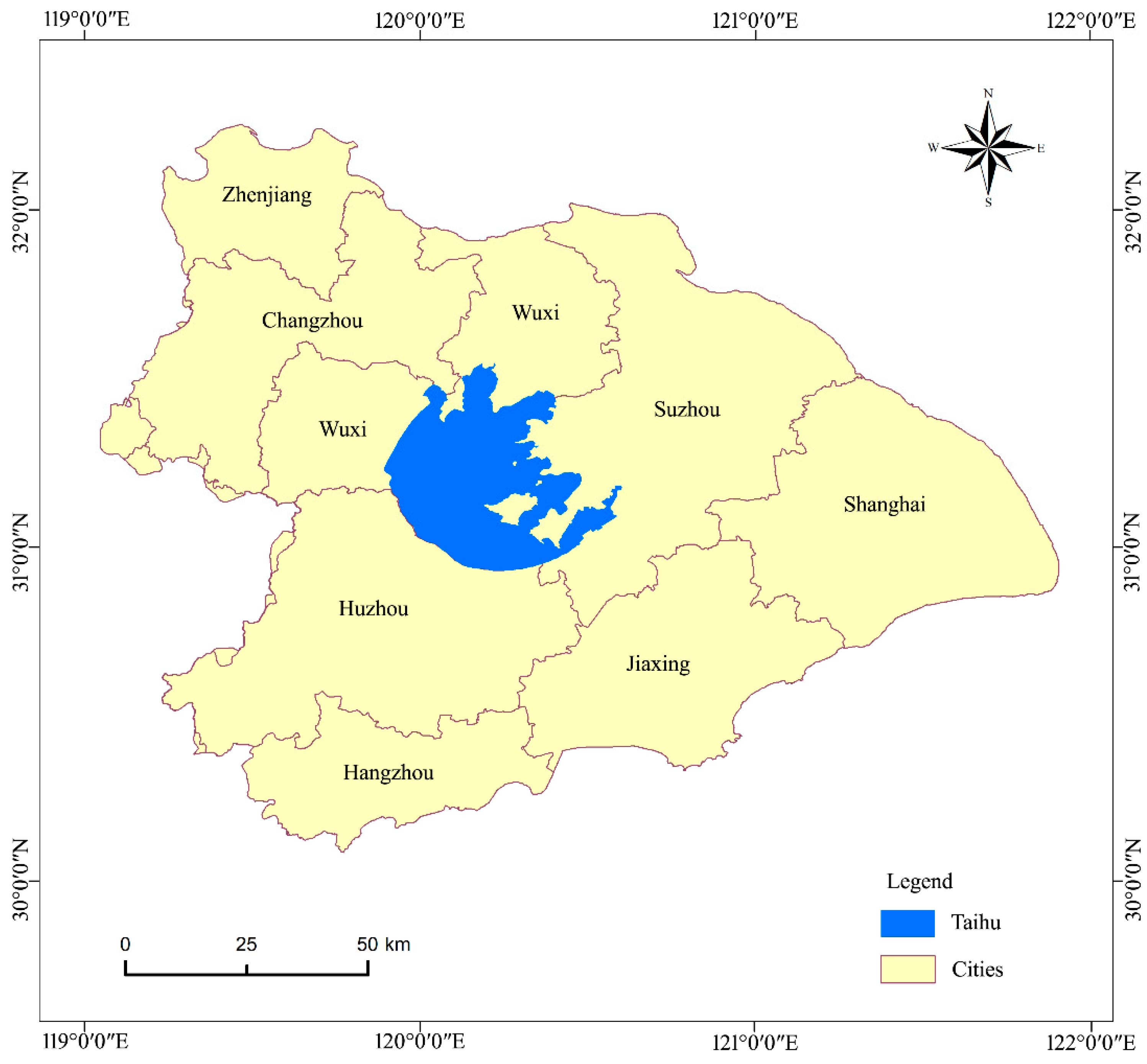
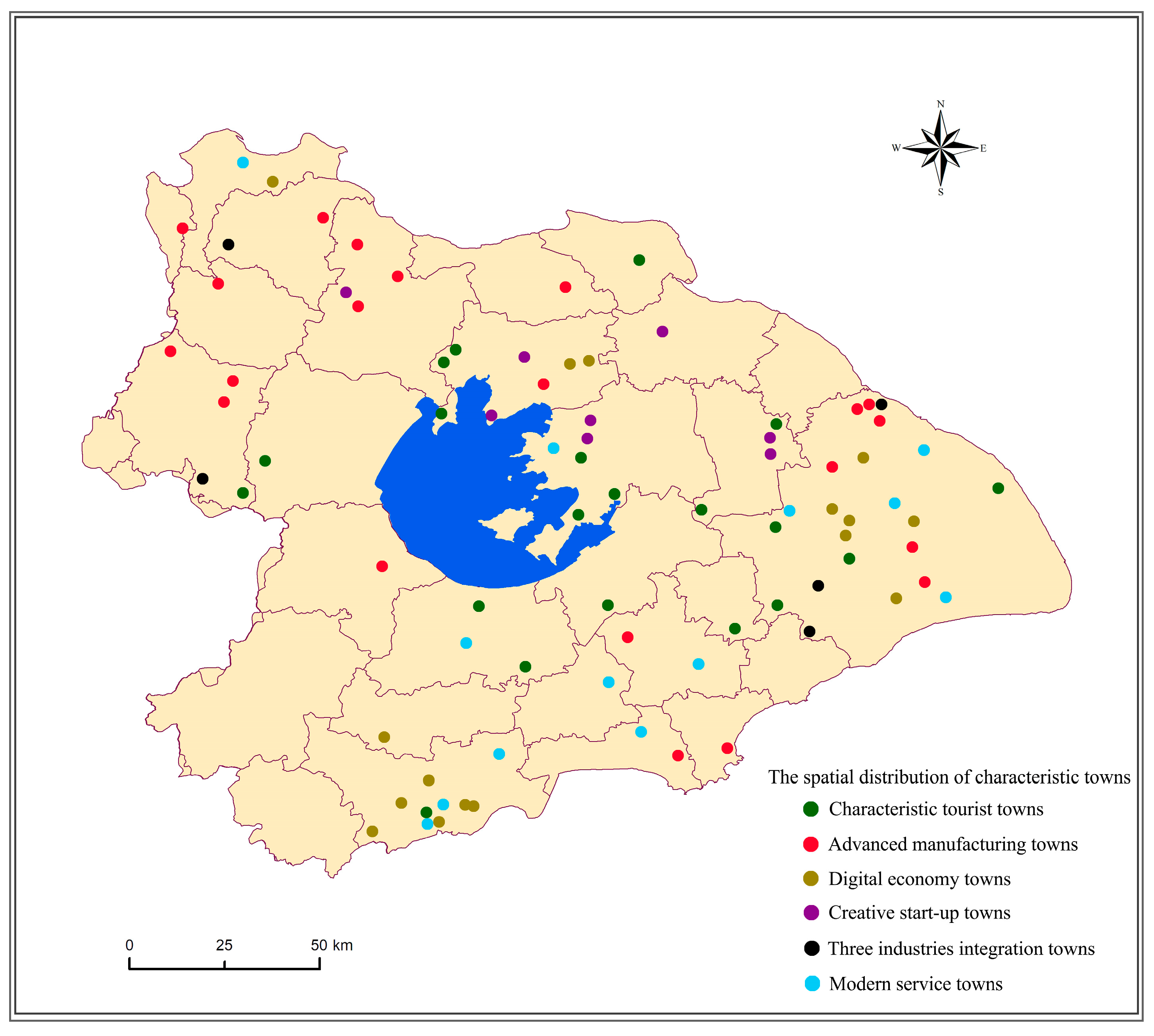
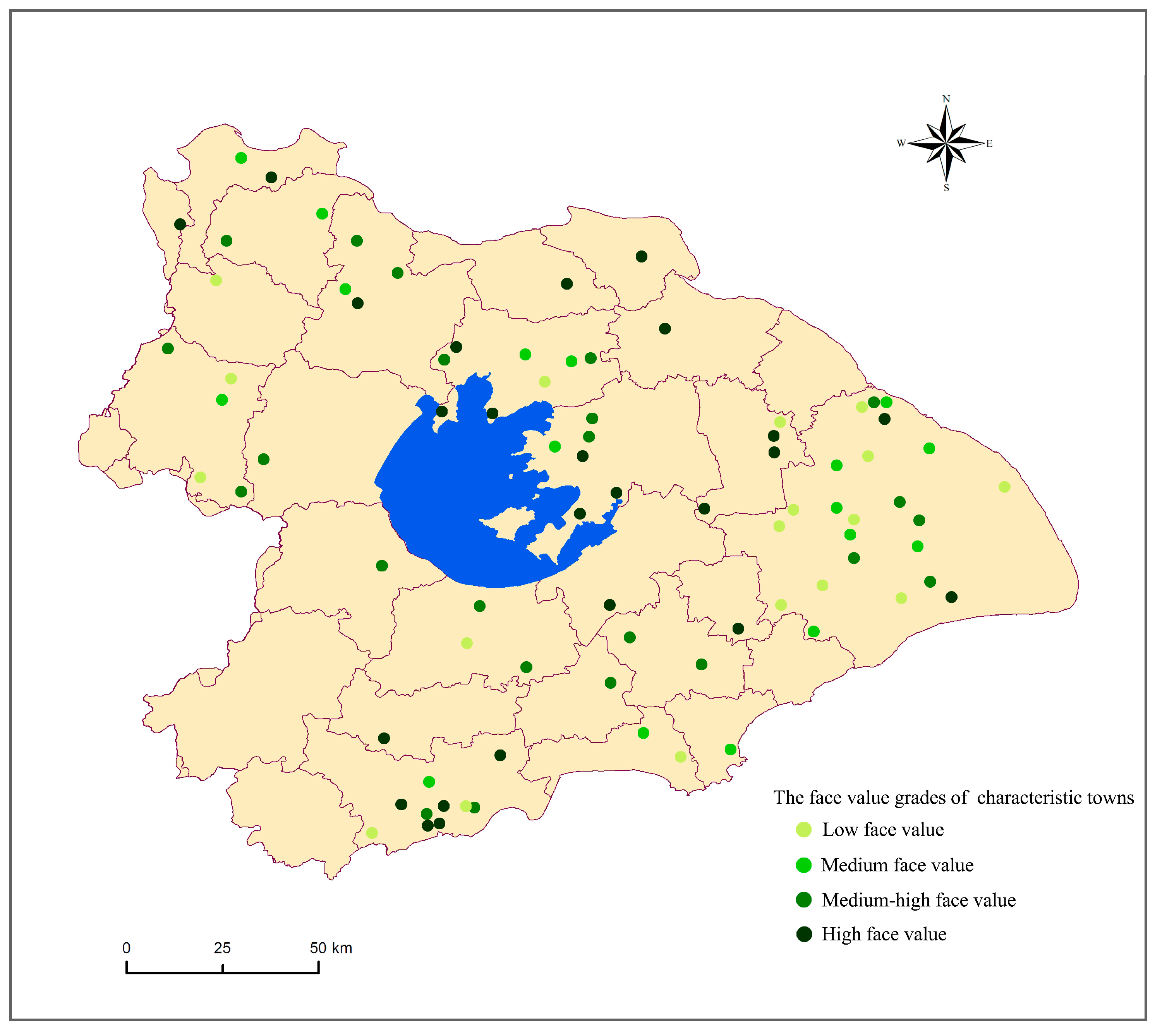
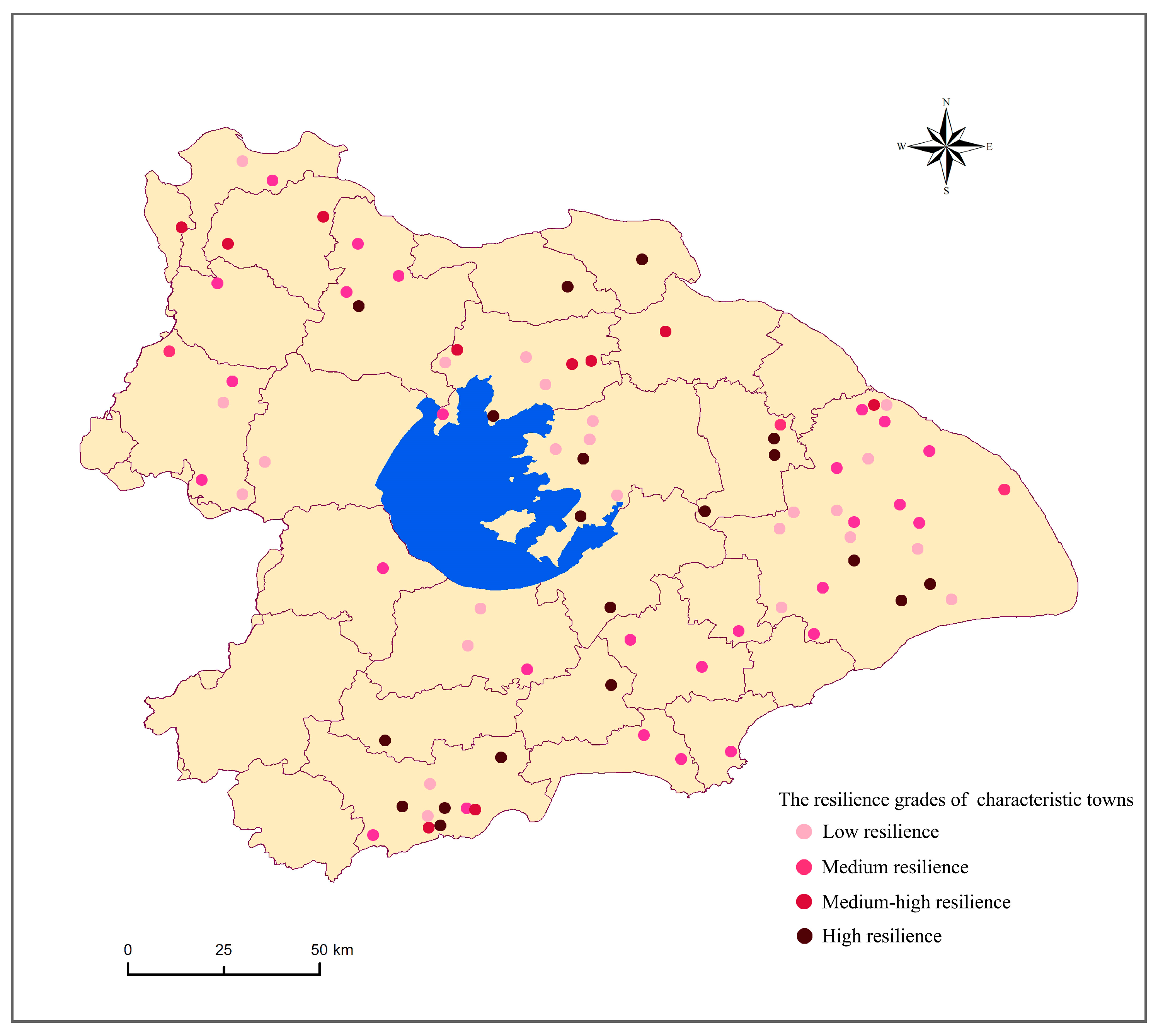
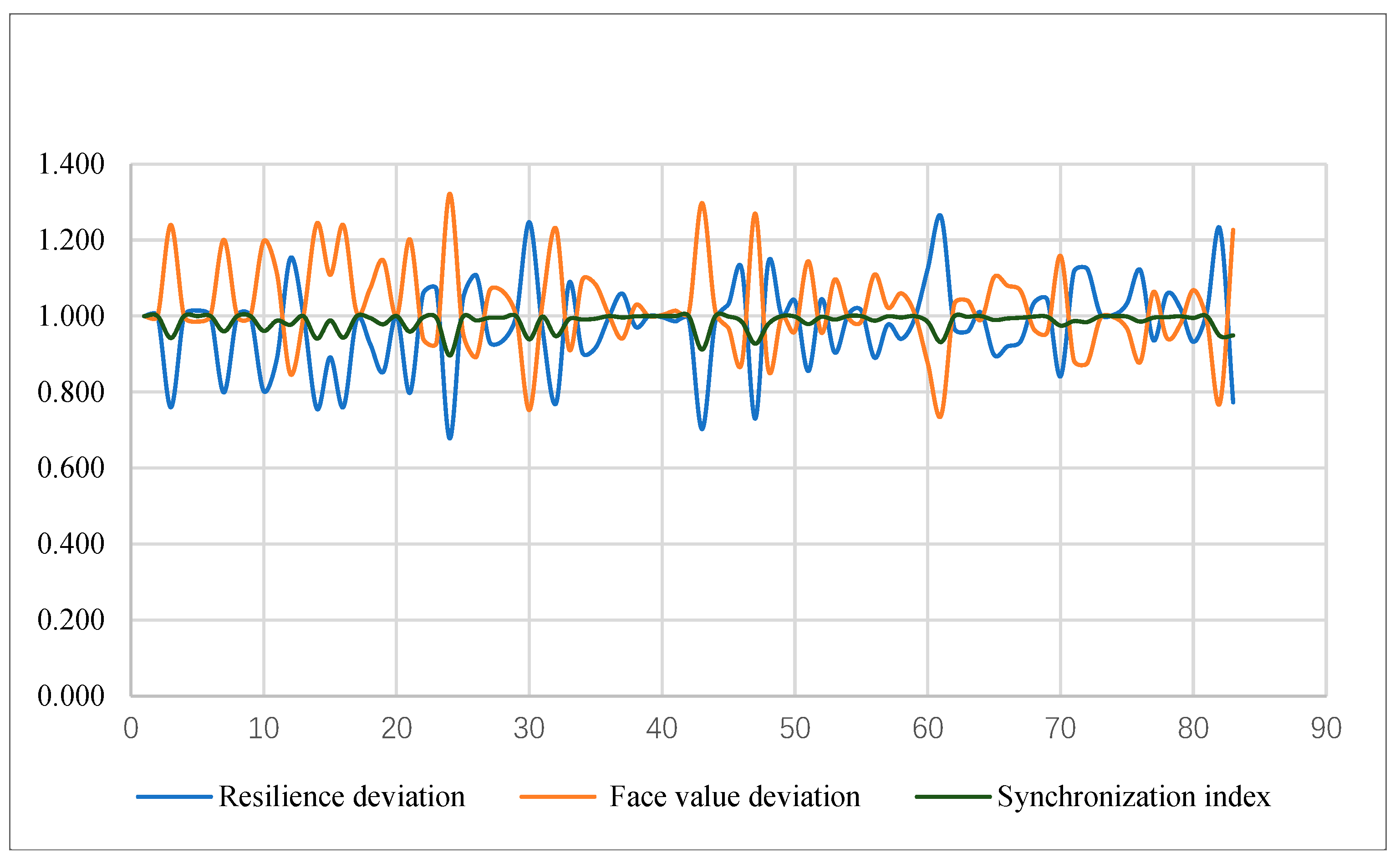
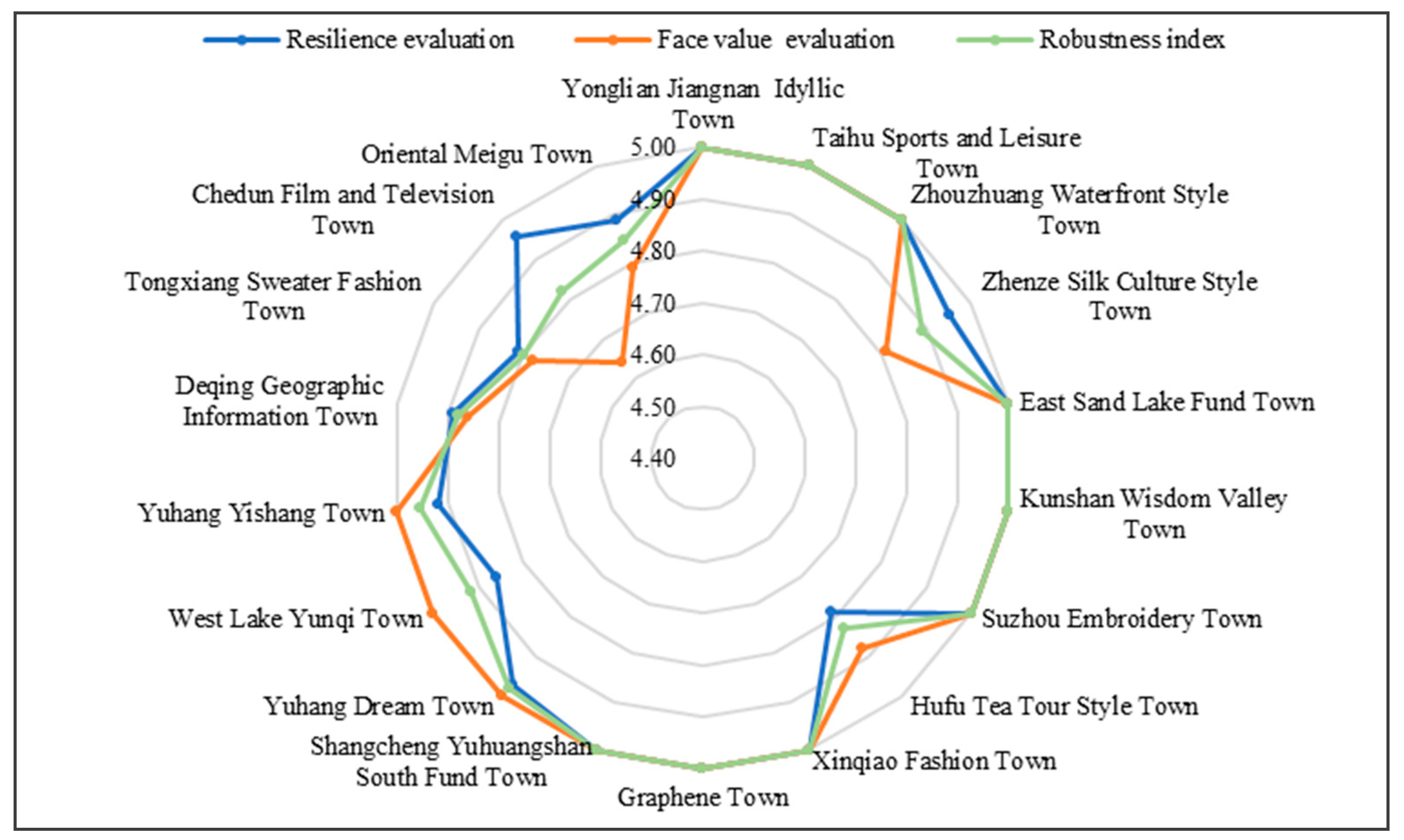
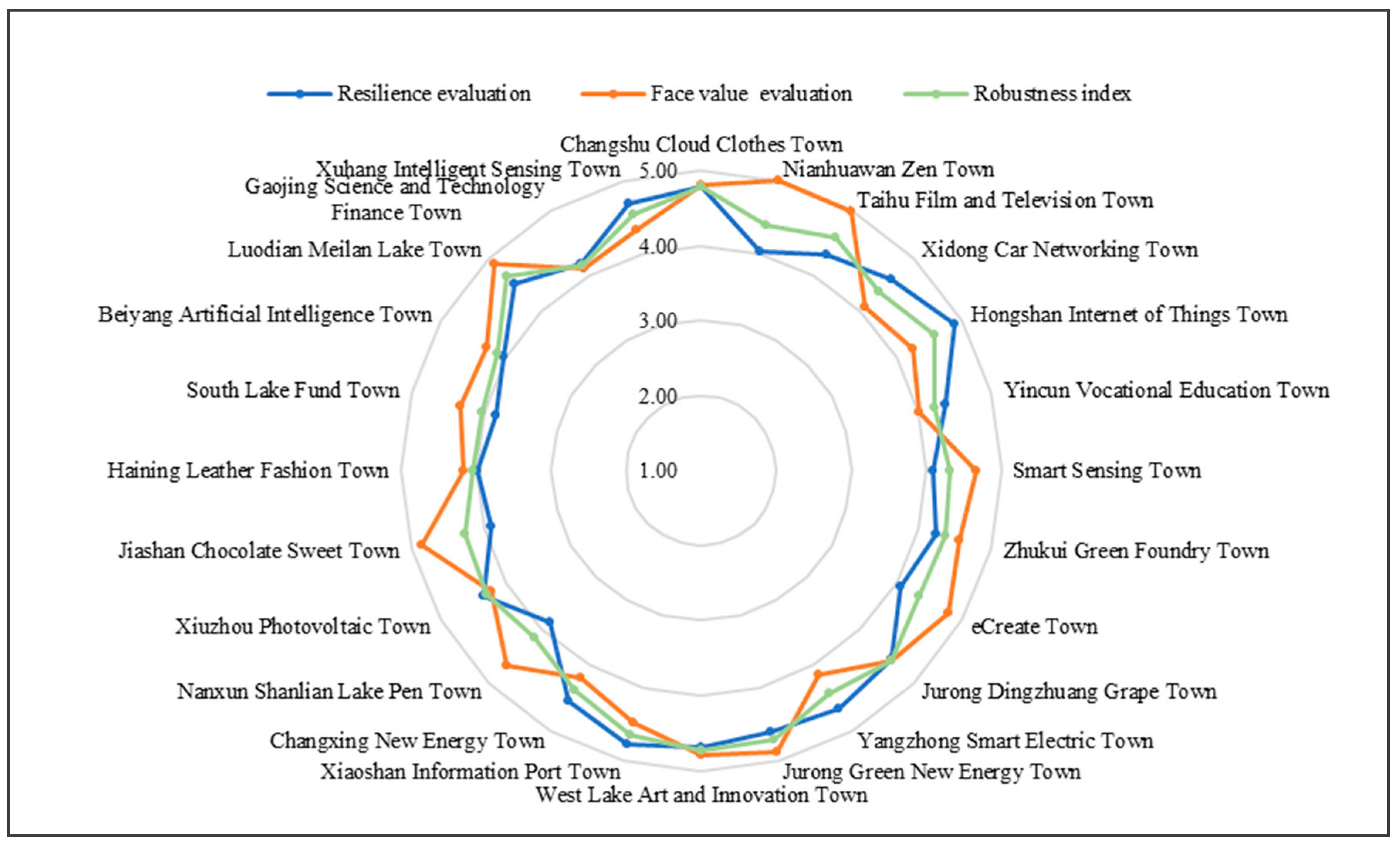
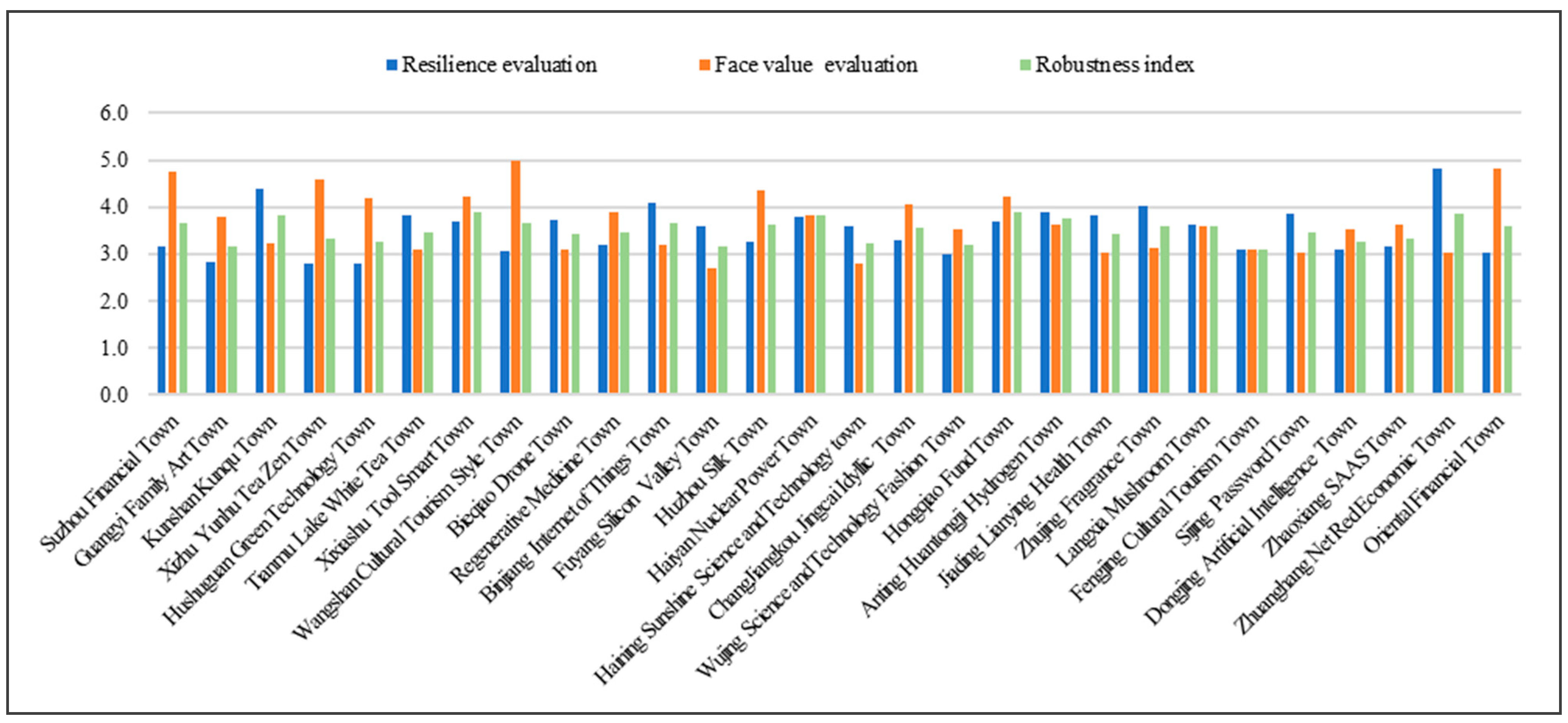
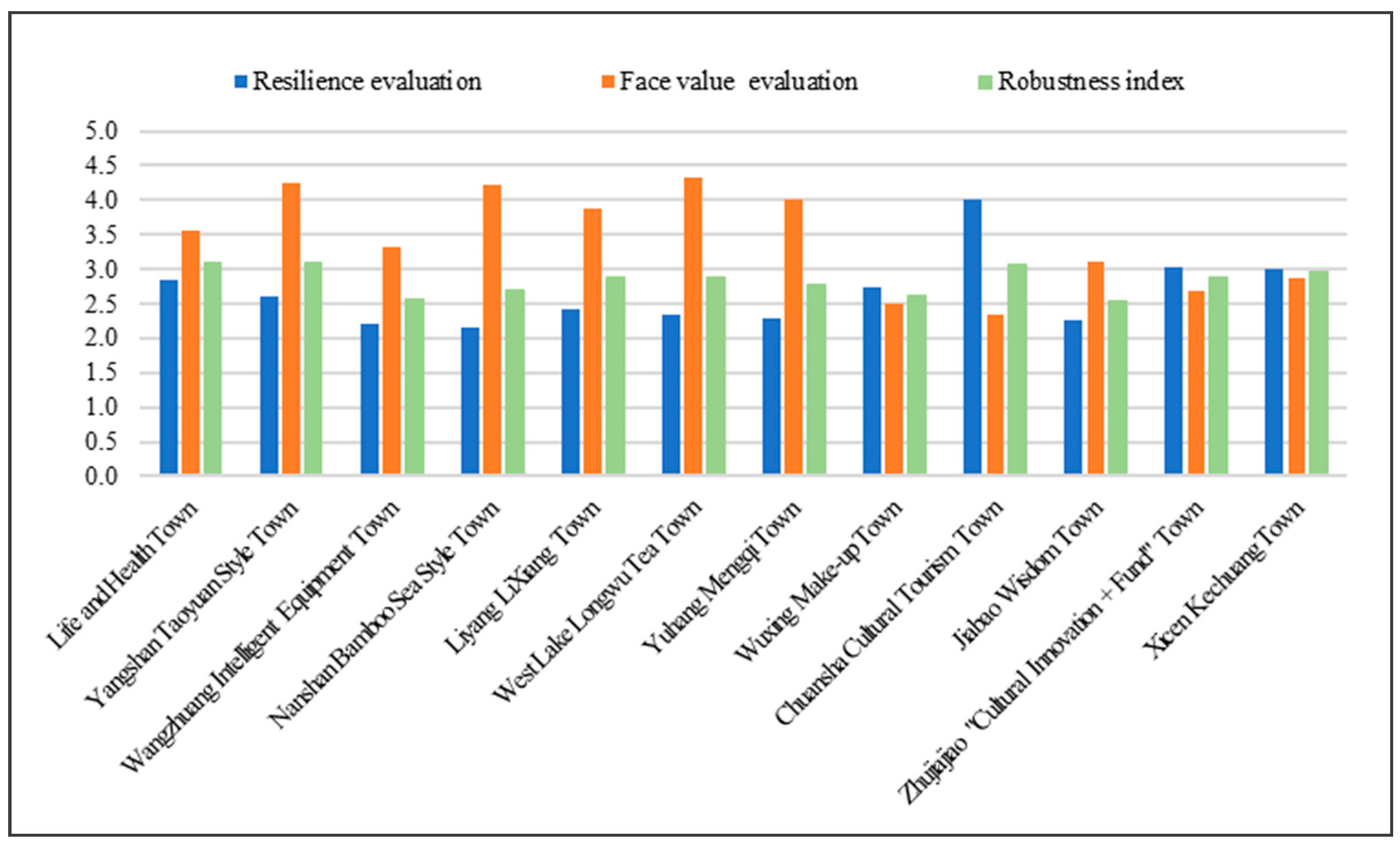
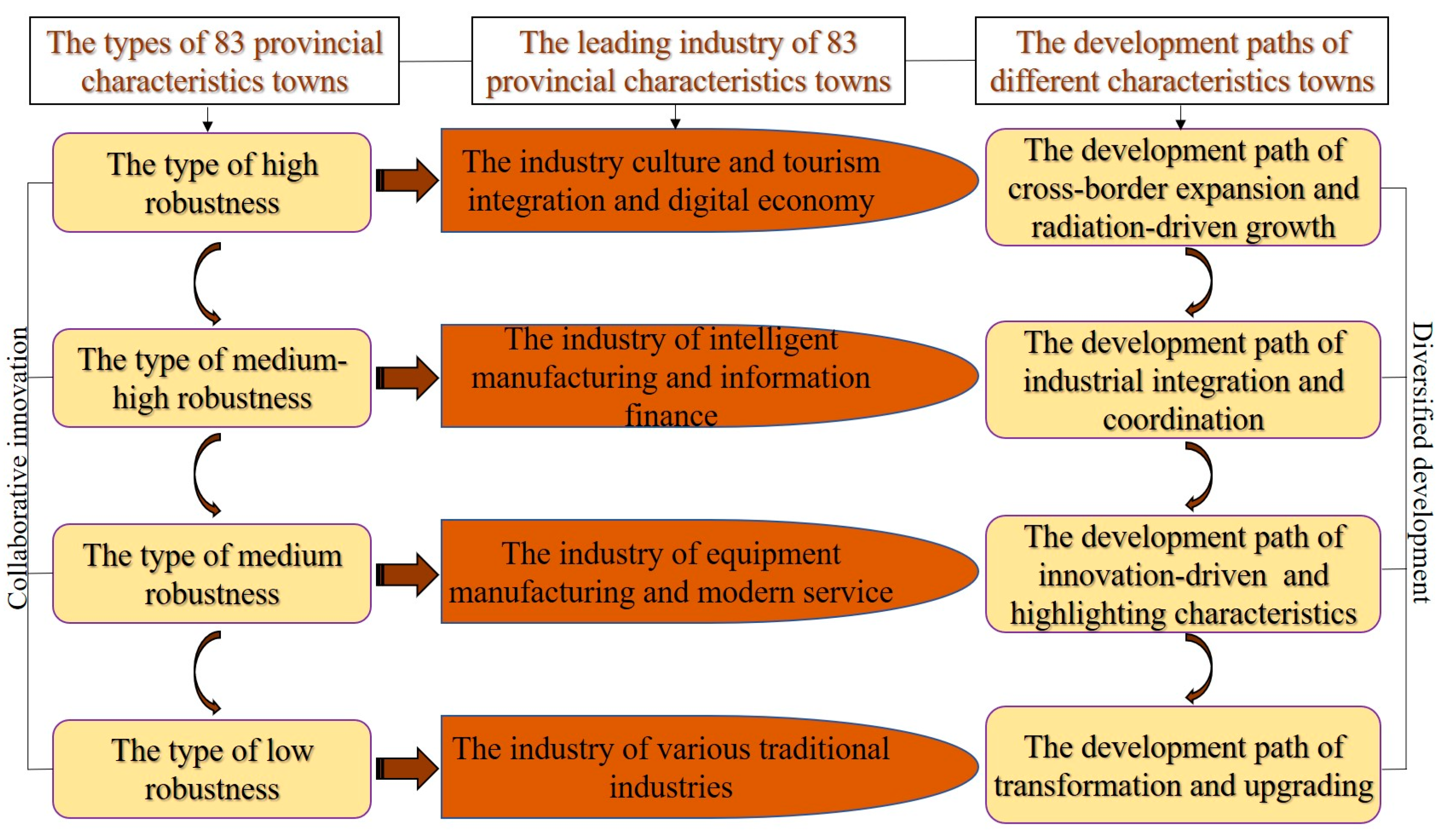
| Target Layer | Criterion Layer | Index Layer | Target Layer | Criterion Layer | Index Layer |
|---|---|---|---|---|---|
| The face value level | Ecological coordination | Green and low-carbon development | The resilience level | Economic resilience | GDP per land |
| Visual satisfaction | Number of incoming companies | ||||
| Environmental landscape | A-level scenic spot evaluation | Structural resilience | The proportion of service industries | ||
| Landscape features | Proportion of emerging industries | ||||
| Architectural form | Industrial resilience | Location entropy of tourism industry | |||
| Greening cleanliness | The afforested area | Degree of industrial integration | |||
| Floor cleanliness | Innovation resilience | Internal expenditure of R&D expenditure | |||
| Supporting perfection | Abundance of educational and medical resources | Output value of new products | |||
| Facility convenience | Spatial resilience | Spatial network connection | |||
| Service sharing | Share the economic dividend | Regional traffic links | |||
| Happiness index | Distance from the central city | ||||
| Humanistic quality | Cultural temperament | Governance resilience | Subject participation | ||
| Humanistic emotions | Mayor’s governance ability |
Disclaimer/Publisher’s Note: The statements, opinions and data contained in all publications are solely those of the individual author(s) and contributor(s) and not of MDPI and/or the editor(s). MDPI and/or the editor(s) disclaim responsibility for any injury to people or property resulting from any ideas, methods, instructions or products referred to in the content. |
© 2023 by the authors. Licensee MDPI, Basel, Switzerland. This article is an open access article distributed under the terms and conditions of the Creative Commons Attribution (CC BY) license (https://creativecommons.org/licenses/by/4.0/).
Share and Cite
Wang, G.; Zhang, M.; Liu, Y.; Zhou, L.; Xia, Y. The Green and Adaptable Development Paths of Provincial Characteristic Towns in Taihu Lake Basin: A Synergy Perspective on Face Value and Resilience. Sustainability 2023, 15, 7685. https://doi.org/10.3390/su15097685
Wang G, Zhang M, Liu Y, Zhou L, Xia Y. The Green and Adaptable Development Paths of Provincial Characteristic Towns in Taihu Lake Basin: A Synergy Perspective on Face Value and Resilience. Sustainability. 2023; 15(9):7685. https://doi.org/10.3390/su15097685
Chicago/Turabian StyleWang, Guiling, Mengzhuo Zhang, Yimeng Liu, Li Zhou, and Yuxin Xia. 2023. "The Green and Adaptable Development Paths of Provincial Characteristic Towns in Taihu Lake Basin: A Synergy Perspective on Face Value and Resilience" Sustainability 15, no. 9: 7685. https://doi.org/10.3390/su15097685
APA StyleWang, G., Zhang, M., Liu, Y., Zhou, L., & Xia, Y. (2023). The Green and Adaptable Development Paths of Provincial Characteristic Towns in Taihu Lake Basin: A Synergy Perspective on Face Value and Resilience. Sustainability, 15(9), 7685. https://doi.org/10.3390/su15097685





